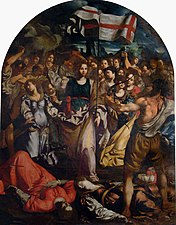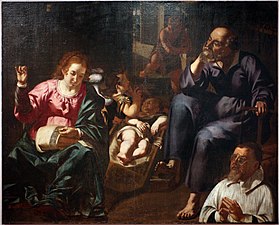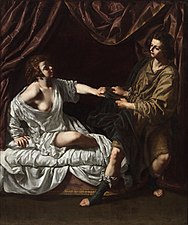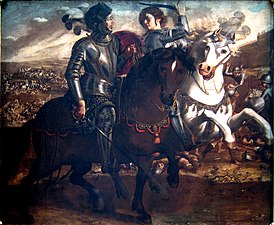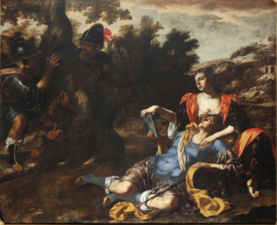Paolo Finoglia
Paolo Finoglia or Finoglio ( Paulus Finolius Neapolitanus ; also Paolo Domenico F .; around 1590 in Orta di Atella or Naples - between April and September 1645 in Conversano ) was an Italian painter of the early Baroque from the Neapolitan school , who lived in Naples and especially in Apulia worked.
Life
There is no documented information about Finoglia's place of birth or birthday. According to De Dominici (1743) he was born around 1590 in Orta d'Atella near Naples. The middle name "Domenico", which is sometimes used in the literature, cannot be found in contemporary documents. He signed his works and letters with Paulus Finolius Neapolitanus . Nothing is known about his training either, De Dominici's statements about the teachings of Battistello Caracciolo and Massimo Stanzione are not certain and are more likely based on speculation. Younger authors suggest that a late mannerist painter like Ippolito Borghese was his teacher.

In the second decade of the 17th century, Finoglia was in the Salento area and lived in Lecce for a few years . His earliest signed work is a sacrifice of Isaac from a stylistically similar series of four pictures on the story of Abraham in the Dominican church of San Giovanni Battista in Lecce. It is dated MDCX (1610) (but a digit at the end may be missing). A Madonna with angels and Saints Rochus and John the Baptist , dated 1616 , which was once in the community of Supersano (near Ugento), is missing today.
Before May 6, 1623 he married Rosa Lolli from Lecce, with whom he had two children: Beatrice and Giuseppe.
Around this time he went back to Naples to work at the Certosa di San Martino . In the chapter house he painted ten lunettes with holy founders of religious orders and one of his recognized masterpieces, the circumcision , for which he was paid in May 1626. Then he created the decoration of the Chapel of St. Martin, for which he was rewarded with 1200 ducats on August 27, 1631 . Only the ceiling frescoes with scenes from the life of St. Martin ; two murals are lost, the altarpiece with St. Martin was rejected by the monks.
At the beginning of October 1626 he completed the (not preserved) painting The Ten Virgins of the Gospel for the Neapolitan monastery of SS. Trinità delle Monache , and for the Church of Sant'Antonio in Lauria ( Basilicata ), he worked together with Ippolito Borghese on a polyptych for that he was paid on March 26, 1627.

Finoglio's clients also included members of the Naples aristocracy, such as Donna Lucrezia Cardenas, Princess of Squillace, from whom he was paid for various jobs in 1627 through the Pietà bank . For the Spanish court he created (possibly through the viceroy's mediation ) a series of paintings on biblical subjects and those of classical mythology , including a masterful triumph of Bacchus and perhaps the picture Massinissa mourns the death of Sophonisba for the Palacio del Buen Retiro (today: Prado , Madrid).
In 1629 he received the commission for the Maria Immacolata (so-called Pala Bonaiuti ) in the Cappella Bonaiuti by San Lorenzo Maggiore in Naples. Several other versions of the Immacolata have also survived , some of which were made with the collaboration of his workshop, including a. in San Lorenzo (or San Francesco?) in Montesarchio and in the Musée des Beaux-Arts in Lille .
On November 27, 1632 Finoglia acted as godfather for a nephew of Battistello Caracciolo, which indicates that the two were friends. At around the same time he created the baptism of Sts on behalf of Bishop M. de León y Cardenas . Aspreno for the presbytery of Pozzuoli Cathedral (now in Castel Sant'Elmo , Naples).
In mid-1634 at the latest he went back to Apulia to work for Count Giangirolamo (II) d'Acquaviva and his wife Isabella Filomarino in Conversano . His most important work from this late period is the ten-part cycle with episodes from Tasso's Gerusalemme Liberata (Aula consiliare, Municipio, Conversano). At about the same time, but probably with massive involvement of the workshop, the frescoes with stories from Jacob's life were created in the count's room of the Castello of Conversano.
Also on behalf of the Count, he painted five altarpieces for the Franciscan Church of Santi Cosma e Damiano in Conversano, which was rebuilt from 1636 . The church's vault frescos were not completed until after his death in 1650, probably according to his designs.
One of the highlights of his art is the altarpiece Madonna and Child and St. Eligio and Trifone in the Church of Sant 'Angelo in Monopoli . This picture was made for the Order of Paolotti , on whose behalf he also painted a copy after Iacopo Palma il Giovane , a Madonna and Child and St. Roch and Sebastian , which is now in the Cathedral of Monopoli. His last work is the painting of St. Benedict and Biagio for the high altar of the Church of San Benedetto in Conversano, which shows the influences of the Roman Baroque.
Finoglia was also active in the art trade and other monetary transactions. The wedding of his widowed daughter Beatrice to a nobleman from Conversano GB Tarsia in November 1642, at which the first-born son of Count Acquaviva d'Aragona was present as best man, speaks for his social advancement .
Paolo Finoglia died between April and September 1645. He left numerous unfinished works and debts.
The self-portrait by Paolo Finoglia was in 2016 by the city of Conversano for about 25,000 euros bought and has since been seen in the Pinacoteca of the Castello Conversano.
Appreciation / style / work
Paolo Finoglia received little attention for a long time. Only after the restoration of several works, especially the cycle on La Gerusallemme liberata in Conversano, is he counted among the more important Neapolitan painters of the early Baroque. His style combines late mannerist elements with a strong influence of Tenebrism and naturalism by Caravaggio and Battistello Carracciolo and other Naples painters of his time, such as Jusepe de Ribera , Artemisia Gentileschi or Guarino. The dark, hard shadows and his skillful display of precious fabrics are striking.
gallery
The holy family with needlework (“ Santa famiglia del cucito ”), with little Johannes d. Baptist and the Donor , Museo Diocesano, Lecce
Annunciation , Szépművészeti Múzeum , Budapest
Joseph and the wife of Potiphar , Harvard Art Museum / Fogg Museum , Cambridge (Massachusetts, USA)
Tancredi and Clorinda , from the cycle of Tasso's Gerusalemme Liberata , approx. 1634–43, Castello di Conversano
Works
- Four pictures on the history of Abraham , including the sacrifice of Isaac , 1610 (?), San Giovanni Battista, Lecce
- The Virgin of the Apocalypse and Saints , Santa Maria della Serra, Tricase (near Lecce; signed Paulus Finolius Neapolitanus )
- St. Angelo and Joseph and St. John d. Baptist and John of the Cross , San Giovanni Evangelista, Lecce
- The circumcision and lunettes with saints founders of religious orders , 1626, Chapter House of the Certosa di San Martino, Naples
- Madonna with St. Teresa of Avila , Santa Maria Donnaromita, Naples
- Madonna with Child and St. Margaret, Antonius and Bernhard (originally for SS. Bernardo e Margherita, Fonseca) Museo di Castelnuovo
- Maria Immacolata (so-called Pala Bonaiuti ), from 1629, Cappella Bonaiuti by San Lorenzo Maggiore, Naples
- Maria Immacolata , San Lorenzo, Montesarchio
- Maria Immacolata , Musée des Beaux-Arts, Lille
- Martyrdom of St. Sebastian , Museo di Capodimonte, Naples
- Triumph of Bacchus and Massinissa mourns the death of Sophonisba , Museo del Prado, Madrid
- Joseph and the wife of Potiphar , Harvard Art Museum / Fogg Museum, Cambridge (Massachusetts, USA)
- Life of St. Martin , 1631, ceiling frescoes in the chapel of St. Martin in the Certosa di San Martino
- Baptism of St. Aspreno , approx. 1631–34, (originally for the Cathedral of Pozzuoli) Castel Sant'Elmo, Naples
- ten episodes from Tassos Gerusalemme Liberata , approx. 1634–43, Castello von Conversano (or council chamber in the Municipio, Conversano?)
- Stories of Jacob , before 1643 (?), Frescoes in the Castello of Conversano (with the participation of the workshop)
- five altarpieces: St. Dominic heals the blind , baptism of St. Cecilia and Valeriano , martyrdom of St. Gennaro , miracle of St. Anthony of Padua , The Virgin Appears to St. Rosa von Viterbo , approx. 1636–1645, in the church of Santi Cosma e Damiano, Conversano
- Three altarpieces: Annunciation , Madonna with Christ and Maria Immacolata , Church of SS. Annunciata, Airola (near Benevento)
- Blessing God the Father , Sant'Antonio Abate, Campobasso (workshop?)
- Christ appears to St. Gaetano , Bishop's Palace, Taranto (workshop?)
- The Virgin and Child appear to St. Gaetano , Chiesa del Carmine, Grottaglie (workshop?)
- Madonna and Child with St. Eligio and Trifone , Sant 'Angelo, Monopoli
- Madonna and Child and Saints Roch and Sebastian (copy after Palma il Giovane), Monopoli Cathedral
- St. Benedict and Biagio , high altar picture in San Benedetto, Conversano
literature
- Valentina Antonucci: FINOGLIO, Paolo. In: Fiorella Bartoccini (ed.): Dizionario Biografico degli Italiani (DBI). Volume 48: Filoni-Forghieri. Istituto della Enciclopedia Italiana, Rome 1997.
- Silvia Cassani, Mario Sapio: Paolo Finoglio e il suo tempo: un pittore napoletano al la corte degli Acquaviva , Electa, Naples, 2000
Web links
- Finoglia, Paolo Domenico , short biography on the Prado website , Madrid (Spanish; seen May 7, 2020)
- Finoglia, Paolo Domenico , short biography on the website of the Web Gallery of Art (English; viewed May 7, 2020)
- Biography of Paolo Finoglio on the Comune Conversano website under: "Paolo Finoglio" and "Il periodo conversanese" (web archive; Italian; viewed on May 7, 2020)
- Paolo Domenico Finoglia on "Artnet" (seen on May 7th, 2020)
- Finoglio's Triumph of Bacchus on the website of the "Prado" (English / also Spanish; accessed on May 7, 2020)
Individual evidence
- ↑ a b L'autoritratto di Paolo Finoglio torna nella “casa” del pittore , article of October 24, 2016 about the acquisition of Finoglia's self-portrait in “Oggi Conversano.it” (Italian; accessed May 7, 2020)
- ↑ a b c d e f g h i j k l m n o p q r s t u v w x y z Valentina Antonucci: Finoglio (Finoglia), Paolo (Paolo Domenico) , in: Dizionario Biografico degli Italiani , Volume 48 , 1997, online at Treccani , (Italian; accessed May 7, 2020)
- ↑ a b c d e Finoglia, Paolo Domenico , short biography on the website of the Web Gallery of Art (English; viewed on May 7, 2020)
- ↑ Finoglio's Triumph of Bacchus on the website of the "Prado" (English / also Spanish; accessed on May 7, 2020)
- ↑ Massinissa mourns the death of Sophonisba on the Prado website (English / also Spanish; accessed on May 7, 2020)
- ↑ a b Finoglia, Paolo Domenico, short biography on the Prado website , Madrid (Spanish; viewed May 7, 2020)
- ↑ a b On the Harvard Art Museum website (Spanish; viewed May 7, 2020)
| personal data | |
|---|---|
| SURNAME | Finoglia, Paolo |
| ALTERNATIVE NAMES | Finoglio, Paolo; Finoglia, Paolo Domenico; Paulus Finolius Neapolitanus |
| BRIEF DESCRIPTION | Neapolitan painter of the early baroque |
| DATE OF BIRTH | around 1590 |
| DATE OF DEATH | 1645 |


